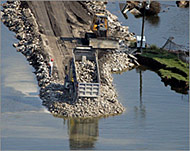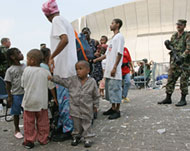New Orleans begins gathering bodies
With the last weary refugees rescued from the Superdome and convention center, New Orleans on Sunday turned its attention to gathering and counting the dead.

No one knows how many people were killed by Hurricane Katrina and how many more died waiting to be rescued.
But the bodies are everywhere: hidden in attics, floating in the ruined city, crumpled in wheelchairs, abandoned on highways.
“I think it’s evident it’s in the thousands,” Health and Human Services Secretary Michael Leavitt said on Sunday on CNN, echoing predictions by city and state officials last week about the death toll.
Craig Vanderwagen, rear admiral of the US Public Health Service, said one morgue, at a St. Gabriel prison, expected 1000 to 2000 bodies.
Grim prediction
“We need to prepare the country for what’s coming,” Homeland Security Secretary Michael Chertoff said on Fox News Sunday. “We are going to uncover people who died, maybe hiding in houses, got caught by the flood. … It is going to be about as ugly of a scene as I think you can imagine.”
On Sunday morning, a woman’s body remained lying at the corner of Jackson Avenue and Magazine Street, a business area in the lower Garden District with antique shops on the edge of blighted housing. The body had been there since at least Wednesday.
 |
|
Work continues on rebuilding the |
As days passed, people covered her with blankets or plastic.
By Sunday, a short wall of bricks had been built around her body, holding down a plastic tarpaulin. On it, someone had spray-painted a cross and the words, “Here lies Vera. God help us.”
Outside the convention center on Sunday, where walk-up stragglers and those picked up by rescuers were being evacuated, Navy Lieutenant Andy Steczo of Bossier City, Louisiana, was dressing a gash on 56-year-old Pedro Martinez’s ankle and cuts on his knuckle and forearm.
Martinez said he was injured while helping people onto rescue boats. “I don’t have any medication and it hurts. I’m glad to get out of here,” he said.
Steczo, who came with other personnel from the Jacksonville Naval Hospital, was among medics checking evacuees before they leave. Bullet wounds, knife wounds, infections, dehydration and chronic problems such as diabetes were among the problems he had dealt with.
“We’re cleaning them up the best we can and then shipping them out,” Steczo said.
Scavenging
Some victims scavenged what they could find among the detritus left behind.
John Henry picked up a pair of hiking shoes, a pair of tennis shoes that looked unworn, packs of cigarettes and a variety of spirits, including bottles of cognac and Jack Daniels. “We’re looting the people who were looting,” he said, cackling. “I love it. I have to admit it.”
The last 300 refugees at the Superdome were evacuated on Saturday evening, eliciting cheers from members of the Texas National Guard who had been standing watch over the facility for nearly a week as about 20,000 hurricane survivors waited for rescue.
Damage assessment
On Sunday, utilities planned to send trucks into the city to assess storm damage for the first time since Katrina struck last Monday. Morgan Stewart, a spokesman for electricity provider Entergy Corp., said the National Guard would escort the company’s vehicles.
 |
|
The Superdome was evacuated |
The exact number of dead will not be known for some time.
Survivors were still being plucked from roofs and shattered highways across the city. President Bush ordered more than 7000 active duty forces to the Gulf Coast on Saturday.
The majority of those stranded after Katrina were those without the resources to escape.
Tens of thousands of people had been evacuated to Texas, Tennessee and other states.
Running out of room
Texas Governor Rick Perry warned on Saturday that his enormous state was running out of room, with more than 220,000 hurricane refugees camped out there and more coming.
Emergency workers at the Astrodome were told to expect 10,000 new arrivals daily for the next three days.
 |
|
Much of New Orleans remained |
In Washington, Transportation Secretary Norman Mineta announced that more than 10,000 people had been flown out of New Orleans in what he called the largest airlift in history on US soil.
Thousands of people remained at Louis Armstrong New Orleans International Airport, where officials turned a Delta Blue terminal into a triage unit. Officials said 3000 to 5000 people had been treated at the unit, but fewer than 200 remain. Others throughout the airport awaited transport out of the city.
Airport director Roy Williams said about 30 people had died, some of them elderly and ill. The bodies were being kept in refrigerated trucks as a temporary morgue.